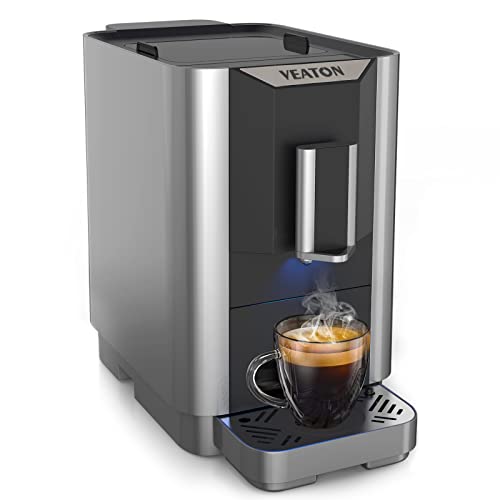How to Make Espresso Machine Coffee
An espresso machine can produce delicious cups of coffee, but it needs some extra setup and maintenance than a regular drip coffee maker. It is also necessary to grind and tamp the beans yourself.
Pressure is the main ingredient in making espresso. How an espresso machine works is that a heating vessel heats the water to the ideal temperature before forcing it out of the spouts, and then through the grounds.
Temperature
Espresso is made by forcing hot water, under pressure, through finely ground coffee beans. The temperature of the water is crucial to the final shot. Temperatures that are too low can result in a absence of flavor compounds. High temperatures can cause over extraction and can lead to burnt or bitter tastes.
The ideal temperature for espresso is between 195 and 205 degrees Fahrenheit. This temperature can be achieved by using a grouphead designed to ensure an unchanging temperature and stability throughout the process of brewing. The most well-known type of group head is the E61 that offers a combination of temperature stability as well as pre-infusion capabilities and lever control.
When altering the espresso machine to accommodate different roasts and brew ratios, it is important to consider the impact of temperature on the extraction yield and crema. The ideal temperature will differ according to the roast and beans. However it is a general rule that lighter roasts with higher brew rates need higher temperatures. A reliable thermocouple is essential for maintaining the same temperature.
Pressure
During the brewing process, espresso machine coffee is pushed through finely ground and tamped grounds. This causes chemical reactions that draw out flavors, oils and other soluble components. machines espresso machines is usually more flavorful and richer.
The ideal espresso machine's pressure is nine bars of pressure which is equal to the atmospheric pressure at sea level. The soluble compounds in the coffee bean are best extracted at this pressure.

Some espresso machines boast up to 20 bars of pressure. While these machines are able to reach these levels of pressure however, they may not be in a position to maintain that level of pressure throughout the extraction.
To put that into perspective To put it in perspective, one bar of pressure is equivalent to the 32 pounds per square inch PSI of a car tire. It's also more than four times the pressure that a professional cyclist uses when pumping up their bike tires. Every serious home barista needs to be able control the pressure of their espresso machine and make consistent espressos.
Water
Water is the most important ingredient in a great cup of espresso. The correct water can help your beans to extract their full potential. However the wrong type of water could cause problems such as clogged pipes and damage to your expensive machine.
The best choice is a natural spring water that is rich in minerals for optimal espresso extraction. This water will enhance the flavor of your espresso without the chalky mineral traces that come from tap water or bottled water. This is an excellent alternative to distilled or reverse osmosis filtered water, which may be too pure and cause issues with flavor.
You should not make use of a water filtration system that removes too much mineral content from your tap water. This could cause taste and extraction issues. Get a water test kit to determine the average hardness of the water you drink in your area. This information can be used to determine the ideal filtration system for your espresso machine.
Beans
The majority of coffee enthusiasts tend to be very involved throughout the process of making espresso. They are obsessed with a variety of variables, such as temperature, water pressure, beans, milk, viscosity and other aspects. If one of the variables is not in order, the entire shot could taste bad.
The most important thing to consider when it comes to espresso is the beans used. Many believe that only certain types are suitable for espresso. While certain beans are suitable for specific uses but any coffee bean can be used to make espresso. The main difference between espresso beans and regular coffee beans is that espresso beans are roasted longer, tipycally past the second crack, which gives them a darker appearance and makes them more water-soluble.
The best beans for espresso are generally medium roasted or dark roasted, which give the espresso shots their distinctive richness and vigor. Lightly roasted beans can be used to make excellent espresso, particularly if they are pre-ground for convenience in an espresso maker.
Milk
Espresso and milk is a classic combination. The combination of espresso and milk is an iconic. It does not only improve energy levels, but it also balances the bitterness in the espresso. This is among the best culinary pairings!
If you decide to purchase an espresso machine that can make latte or cappuccino, be sure to take a look at how simple it is to use. Many of the top espresso machines come with an ice cube that can be filled with hot or cold milk along with a steam wand and an espresso portafilter to pull the shot. Some models come with an integrated grinder, tamper and frother.
The steam wand needs to be purged before using it for the first time in a day (or after each cup of espresso) to remove any water that has condensed. This process takes about 30 seconds, and is necessary to ensure that your machine runs smoothly. Failure to purge can result in a bitter taste or build-up of bacteria that could alter the flavor and aroma of your drinks. It's not difficult to do and should be part of your routine maintenance schedule.
